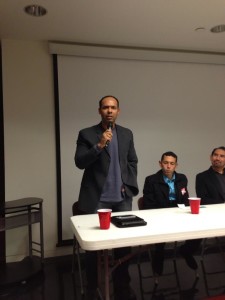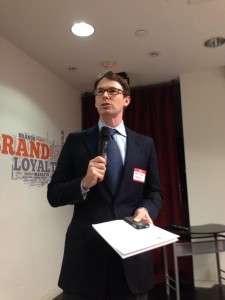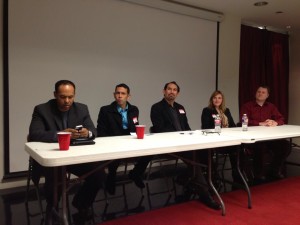By LAURA LOREK
Founder of Silicon Hills News

Duane La Bom with the Open Cloud Academy
The demand for high tech workers outstrips the supply.
So
Rackspace Hosting came up with an innovative solution. The San Antonio-based company launched the
Open Cloud Academy last year to put people through a rigorous training program that equips them to do jobs as network systems administrators and other technical positions.
“I can get you job ready in a matter of two to three months,” said Duane La Bom, director of training at Rackspace and director at the Open Cloud Academy.
La Bom spoke on a panel at
FreeFlow Research’s New Rules, New Tools San Antonio event Monday night at Geekdom. The panel focused on new training opportunities to match skilled workers with jobs. It also touched on new ways to raise money for startups through equity-based crowdfunding.

Peter French, founder of FreeFlow Research
Peter French, founder of FreeFlow Research, also announced his startup has merged with John Hill’s
Technology Connexus Association, a nonprofit technology research organization. FreeFlow Research will continue to be based at
Geekdom and will also sponsor more events in coming months, French said.
The other panelists included Andres Traslavina with
MyEdu, an Austin-based startup, Luis Martinez with Trinity University, Joy Schoffler with Leverage PR and CF50 and Nathan Roach with Greenhouse.
Originally, Rackspace planned to hire about a third of the graduates from the Open Cloud Academy. But to date, it has hired 68 percent of the graduates, La Bom said. The other 30 percent have found jobs with other companies, he said.
The Open Cloud Academy also focuses on helping military veterans find jobs in the commercial world and it adds some diversity to the typical candidates Rackspace hires for IT jobs, La Bom said.
“We wanted to get more females and more minorities into IT. The Open Cloud Academy was a way to do that,” he said.
The Open Cloud Academy classes costs between $3,500 and $4,000 and lasts between eight to ten weeks. Typically, Rackspace paid $12,000 to $15,000 to a recruiter for each technical person it hired. Now it can avoid those costs by training its own IT workers, La Bom said.
Traslavina with MyEdu said the startup helps students plan their careers by using academic tools and simple apps to make their lives easier. MyEdu can also unveil their innate talent and help them visually set up a portfolio of their projects, work experiences and academic credentials, he said.
“We focus on helping recruiters hire potential and not focus on the traditional hiring credentials,” he said. .

New Rules, New Tools San Antonio panel
Trinity University’s focus is on undergraduate education and its strength is in equipping students with critical thinking skills, said Martinez with Trinity.
“We match students with opportunities for real world experience plus the community here in San Antonio,” Martinez said.
San Antonio’s entrepreneurial community is like Boston in the 1980s, Martinez said. Lots of entrepreneurial ventures and innovate growth is happening in San Antonio right now, he said.
Rackspace has also partnered with high school programs to recruit younger students to pursue careers in Information Technology jobs, La Bom said.
And the Open Cloud Academy does not yet have specific funding for veterans yet, but Project Quest and Workforce Solutions Alamo both provide scholarships to attend the programs.
Project Quest covers 50 percent of the tuition costs for students who qualify and also reimburses them up to two months rent and provides money for utilities and childcare costs too.
The Workforce Solutions Alamo provides funding through a Federal fund.
To date, 20 students have received a full scholarship to attend the Open Cloud Academy under that program and another 45 received funding through Project Quest, La Bom said.
Geekdom is a sponsor of Silicon Hills News
![]() TrueAbility Monday released its predictions for hiring trends for technology workers in 2014.
TrueAbility Monday released its predictions for hiring trends for technology workers in 2014.